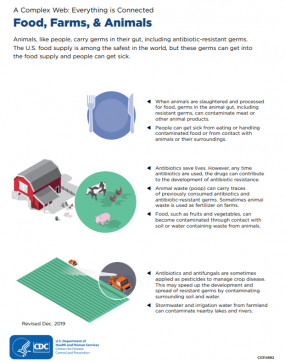Where Resistance Spreads: Food Supply

The U.S. food supply is among the safest in the world, but people can still get sick from foodborne infections or from contact with animals and their environments. CDC estimates that each year 48 million people get sick from a foodborne illness. These infections can be caused by antimicrobial-resistant bacteria. Germs like Campylobacter, Salmonella, and Shigella cause an estimated 742,000 antimicrobial-resistant infections each year. The number of drugs these germs are resistant to seems to be increasing.
How Germs Can Spread to People from the Food Supply
Animals, like people, carry germs in their gut, which can include antimicrobial-resistant germs. These germs can spread between animals and in their environments (such as on farms, in animal markets, and during transport). When animals are slaughtered and processed for food, these germs can contaminate meat or other animal products.
Animal waste can also carry antimicrobial-resistant germs. Fruits, vegetables, and other produce can become contaminated through contact with soil or water containing untreated or un-composted waste from animals.
People can get infections from food in different ways:
- From handling or eating meat, seafood, milk, or eggs that are raw or undercooked and contaminated with resistant germs
- From handling or eating fruits and vegetables contaminated with resistant germs
- From contact with untreated or un-composted animal waste, either directly or when it gets into water and the environment
- From touching or caring for animals without proper handwashing
Additionally, antibiotics and antifungals are sometimes applied as pesticides to manage plants and crop disease. Learn more about antimicrobial resistance in the environment.
About Antibiotic/Antifungal Use in the Food Supply
Antibiotics and antifungals are valuable tools. However, any use—for people, animals, or plants—can cause side effects and contribute to antimicrobial resistance. Most of the time, antibiotics and antifungals are not needed to treat foodborne illnesses. Avoiding unnecessary use helps slow the spread of antimicrobial resistance. However, some people may get more severe infections and antibiotics and antifungals can be lifesaving. People at risk for severe infections include young children, pregnant women, older adults, and people with other health conditions. Talk with your healthcare provider and learn more about antibiotic use and human health.
Antibiotic and antifungals use in food animals can help treat, control, and prevent bacterial diseases in animals. However, to slow the spread of antimicrobial resistance, these drugs should only be used when necessary. CDC supports judicious use of antibiotics and antifungals in people and animals, including the important work that the U.S. Food and Drug Administration (FDA) and U.S. Department of Agriculture (USDA) are doing to improve antibiotic use in veterinary medicine and agriculture. Learn how livestock and poultry producers can help stop the spread of antimicrobial resistance.

Download a printable fact sheet highlighting information on this webpage: Everything is Connected: Food, Farm, & Animals [PDF – 1 page].
COVID-19 Impacts Antimicrobial Resistance
Much of the U.S. progress in combating antimicrobial resistance was lost in 2020, in large part, due to the effects of the COVID-19 pandemic. The pandemic pushed healthcare facilities, health departments, and communities near their breaking points.
Find out more about the impact of COVID-19 on antimicrobial resistance in the U.S.
- Clean hands, cooking utensils, and surfaces when preparing food
- Separate raw meat from other foods
- Cook foods to safe temperatures
- Chill leftovers and other foods promptly
- Learn more about food safety tips and other actions to protect yourself and family from resistance
FDA’s 2015 Veterinary Feed Directive (VFD) final rule outlines the process for authorizing the use of VFD drugs (animal drugs intended for use in or on animal feed that require the supervision of a licensed veterinarian) and provides veterinarians in all states with a framework for authorizing the use of medically important antibiotics—those that are important to human health—in feed when needed for specific animal health purposes.
Additionally, implementation of FDA’s Guidance for Industry #213 in 2017 significantly changed the way medically important antibiotics can be used in food animals. When the changes were fully implemented, it became illegal to use medically important antibiotics for production purposes, and animal producers now need to obtain authorization from a licensed veterinarian to use them for treatment, prevention, and control of a specifically identified disease. Learn how veterinarians protect patients and people from antimicrobial resistance.
USDA, with FDA and the Environmental Protection Agency (EPA), administers the U.S. National Residue Program (NRP) to prevent residues that pose a potential threat to human health from entering the food supply.
Understanding Food Labels
USDA requires documentation [PDF – 18 pages] from food producers to approve labels. Food labels on meat and poultry like “No Antibiotics Ever (NAE)” or “Raised Without Antibiotics,” and “No Added Antibiotics” mean that source food animals never received antibiotics. When these labels accompany a seal that states “USDA Process Verified,” it means USDA inspectors visited the farm to verify antibiotic use.
However, these products can still carry antimicrobial-resistant bacteria. All animals carry bacteria in their gut, and some of these can be resistant, even if the animal never receives antibiotics. These resistant bacteria can spread between animals and into food products.
Other Resources
- Antimicrobial Resistance and Food Safety
- National Antimicrobial Resistance Monitoring System (NARMS)
- NARMS Annual Reports and Data
- Food Safety and Inspection Service’s Meat and Poultry Labeling Terms(USDA)
- FDA’s Strategy on Antimicrobial Resistance(FDA)
- The Judicious Use of Medically Important Antimicrobial Drugs in Food-Producing Animals(#209) (FDA)
- Recommendations for Sponsors of Medically Important Antimicrobial Drugs Approved for Use in Animals to Voluntarily Bring Under Veterinary Oversight All Products That Continue to be Available Over-the-Counter(FDA)
- New Animal Drugs and New Animal Drug Combination Products Administered in or on Medicated Feed or Drinking Water of Food-Producing Animals(FDA)